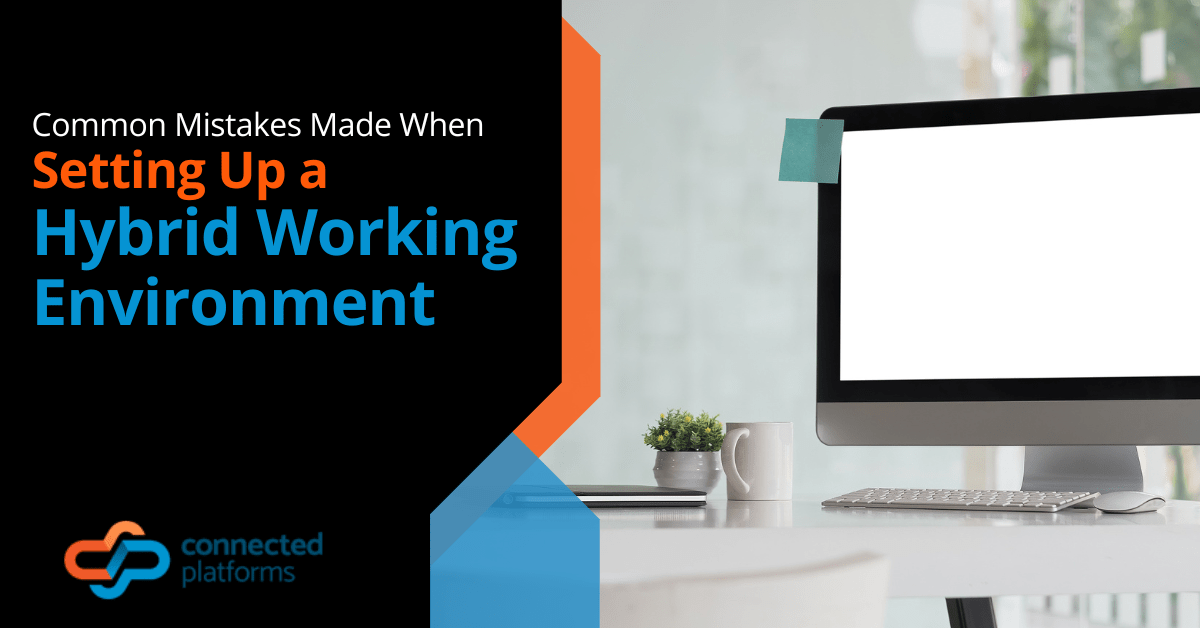The hybrid work environment has become one of the most implemented developments in recent business time, in fact, over 76% of organisations globally could not resist the upgrade from the norm of 9-5 or part-time working models.
A hybrid working environment can offer flexibility for employees, create orderly business diversification, and yield a more productive workforce. In a hybrid working environment, employees can switch between remote and in-person work and set up their workspaces to their personalised needs and preferences.
However, while this work model has been significantly beneficial, it is still new to most businesses. As a result, most companies have not been able to adjust to this system fully and do not yet have a perfect plan to manage teams in different places.
Fortunately, using the right IT solution firm, such as Connected Platforms, can help you set up the right hybrid working environment for your business.
4 Common Mistakes Made When Setting Up A Hybrid Working Environment.
1. Micromanaging Your Team
One of the advantages of creating the remote working system for some people is because the sense of freedom gives them increased creativity in their personal space.
Employers often make the mistake of micromanaging their employees by calling them frequently or sending emails with the purpose of following up on their activities, and for some employees, this leads to frustration which can in no little way affect their overall productivity.
Relaying just the necessary information/instructions and deadlines in a single mail can make your employees feel a sense of trust in their abilities to deliver only the best quality job. Click the link to learn more about email management tips.
2. Poor Communication
Building a different system for communication with remote employees may not be a high priority for some organisations when creating a hybrid working environment. They don’t recognise the need to put different tools in place to facilitate a changing office dynamic.
Employers and team leaders often have platforms to give out tasks, instructions, or any relevant information to subsidiaries. An efficient communication platform for team members is ideal for sustaining team spirit and productivity.
Team members who work in the same building can usually share ideas and vital project information and can often forget to update their team members working remotely.
This can be a disadvantage for remote workers with limited information compared to others. Creating a communication culture among team members can improve the overall communication level, and having training sessions for employees to integrate the hybrid working method easily can also be helpful.
Organisations should always encourage employees to use any convenient communication platform to ensure everyone involved in a project is up-to-date with all information needed to carry out their roles and give feedback accurately.
3. Strict Scheduling
A hybrid working environment is supposed to create a feeling of flexibility in the employees’ mode of working, more time allowance to deliver job results, and a personalised work location.
Taking away the liberty to create flexible schedules can weaken your workforce. In a hybrid work environment, employees often do better when they can choose the days of the week that they would prefer to work in the office.
The organisation should also create a schedule for the physical presence of employees in the office, not just to make an impromptu call for non-emergencies to ask them to come in at the last minute.
Organisations can request a draft of every employee’s daily activity to fix convenient online conference schedules when collaborative tasks need to be done.
4. Zero Error Tolerance
Implementing a hybrid working environment cannot be made perfect from the start. There will definitely be errors while adjusting to this model. The best we can do to avoid this fallacy of a perfect system is by creating room for errors, admitting their inability to have it done all the time, and making positive moves towards learning on the job.
Experts say that a major challenge for organisations and leaders when considering a hybrid work model is the inability to deliver all the answers.
Trying to work with a system without a 100% strategic direction can be a risk not everyone is willing to take. That’s why it is important to be open to the possibility that there would be mistakes. Not being so strict with employees when they make errors and encouraging them can positively impact them and build trust.
Bottom line
The hybrid working environment is a system that will be an integral part of many organisations. The flexibility it offers gives an advantage that can also come with some avenues for some businesses to have gaps and mistakes.
These mistakes can often be taken for granted but can be massive when summed up and weighed by a company. Proper acknowledgement of every error and taking appropriate measures to improve constantly can impact the business’s success.
Organisations should make sure that they communicate their expectations to employees properly and, at the same time, keep an open ear to the employees’ needs.
Contact Connected Platforms to get a good IT firm that can help your business environment be more flexible and adapt to any circumstance.




